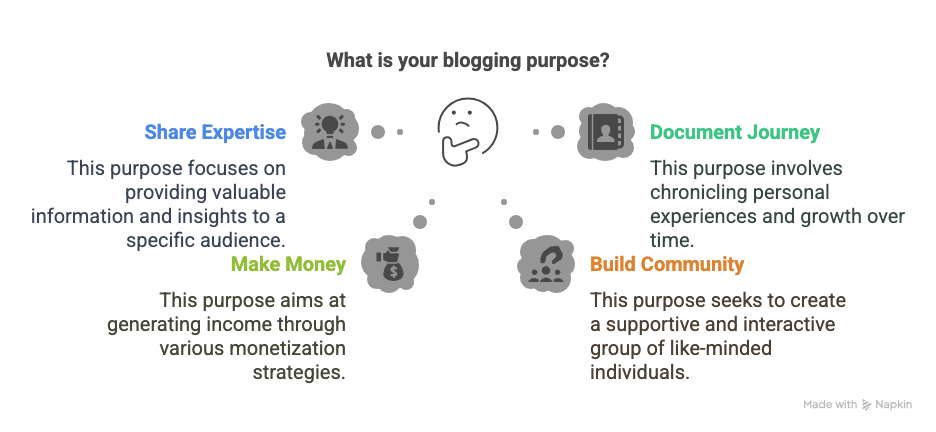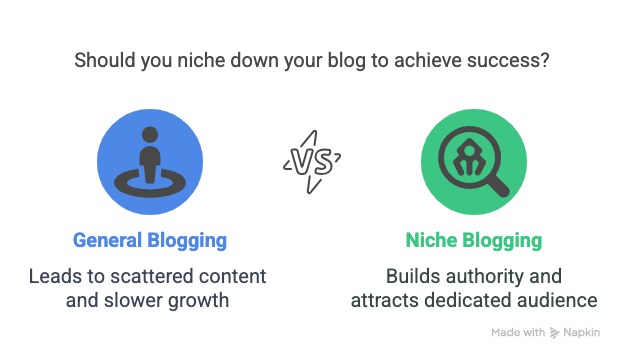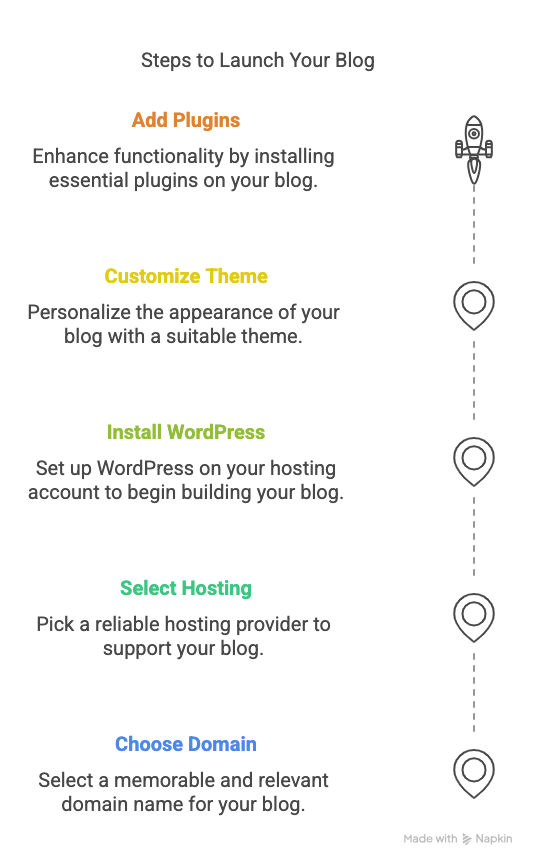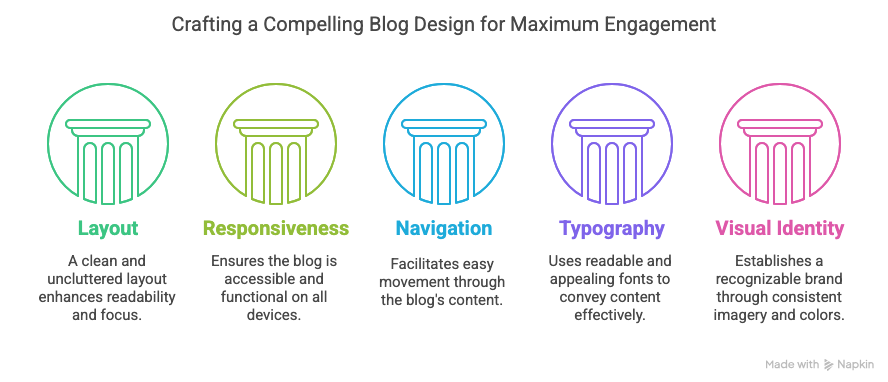Wondering how to start a blog in 2025? The process might seem intimidating at first, but I promise starting a blog is easier than you think. Back in 2015 when I launched my first blog, I stared at my computer screen for hours, completely overwhelmed by all the options. Nevertheless, everyone begins somewhere, and fortunately, today’s blogging platforms make it simpler than ever to get started.
Throughout my 10 years of helping people create and grow their blogs, I’ve consistently seen the same questions pop up again and again. As a result, I’ve put together this comprehensive guide to walk you through everything you need to know to get started on your blogging journey in 2025.
How to Start a Blog: Choosing Your Blogging Purpose
Before you dive into the technical aspects of starting a blog, you need to get clear on why you’re blogging in the first place. This might sound obvious, but trust me — it’s a step many beginners skip, and consequently, they end up frustrated later.
Ask yourself these important questions: Are you blogging to share your expertise? To document your journey? To make money? Or perhaps to build a community? The answers will undoubtedly shape everything from your platform choice to your content strategy.
Initially, I started my first blog just to share travel stories with friends and family. However, it evolved into something much bigger when I realized how many people were searching for authentic travel experiences. Your purpose might change too… and that’s totally okay!

EBlog makes starting your blogging journey simple and effective. Check it out here!
How to Select the Perfect Blogging Niche
One of the biggest mistakes I see new bloggers make when learning how to start a blog is trying to write about everything under the sun. I did this too! Eventually, I learned that successful blogs typically focus on a specific niche.
Why Niching Down Matters When Starting a Blog
When you focus on a specific topic, you can:
- Build authority faster
- Attract a dedicated audience
- Have clearer content direction
- Improve your chances of monetization
- Stand out from general blogs
Best Blogging Niches in 2025 for New Bloggers
Based on current trends and engagement metrics, these niches are performing particularly well for those starting a blog:
- Sustainable living and eco-friendly products
- Mental health and wellness
- Personal finance for millennials and Gen Z
- Specialized technology reviews
- Remote work and digital nomad lifestyle
- Niche cooking (think specific diets or cultural cuisines)
Choose something you’re genuinely passionate about — because after all, you’ll be creating content about it for a long time!

How to Start a Blog: Choosing the Right Platform
This decision can significantly impact your blogging experience. Let me break down the top options for starting your blog:
WordPress.org (Self-Hosted)
This is what I use and recommend for most bloggers who are serious about learning how to start a blog with growth potential. It’s like owning your own house instead of renting — complete freedom, but more responsibility.
Pros:
- Complete ownership and control
- Unlimited customization options
- Thousands of themes and plugins
- Better SEO capabilities
- Full monetization freedom
Cons:
- Slight learning curve
- You handle maintenance and security
- Costs for hosting and premium themes/plugins
EBlog helps you master WordPress blogging without the technical headaches. Try it here!
WordPress.com
The simplified, hosted version of WordPress that’s great for absolute beginners figuring out how to start a blog.
Pros:
- Easy to set up and use
- Basic plan is free
- Maintenance handled for you
Cons:
- Limited customization on free plans
- Restrictions on monetization
- WordPress.com branding unless you upgrade
Other Popular Platforms for Starting a Blog
- Wix: Great drag-and-drop builder, but limited flexibility as you grow
- Squarespace: Beautiful designs but fewer customization options
- Medium: Super easy to start but you don’t own your platform
- Substack: Excellent for newsletter-based blogs with paid subscriptions
- Ghost: Clean interface, great for membership sites
After trying most of these platforms, I’ve discovered that self-hosted WordPress offers the best balance of usability and growth potential for most people learning how to start a blog.
Step-by-Step Guide on How to Start a Blog
Let’s get practical. Here’s how to actually set up your blog:
1. Choose and Register a Domain Name
Your domain is your blog’s address on the internet (like myblog.com). Some tips for new bloggers:
- Keep it short and memorable
- Avoid numbers and hyphens if possible
- Make it relevant to your niche
- Check social media availability for the same name
- Consider future-proofing (don’t pick trendy terms that might date quickly)
Interestingly, I spent three days picking my domain name when starting my blog, and I’m so glad I took the time. As a result, it’s become a brand that people recognize!
2. Select a Hosting Provider for Your New Blog
If you’re going with self-hosted WordPress to start your blog, you’ll definitely need hosting. Popular options include:
- Bluehost (great for beginners)
- SiteGround (excellent support)
- Dreamhost (good value)
- WP Engine (premium, WordPress-specific)
Fortunately, most hosts offer one-click WordPress installation, making the process of starting a blog super simple.
Discover why Bluehost is recommended for WordPress sites with one-click installation, reliable uptime, 24/7 support, and beginner-friendly features.
3. Install and Set Up WordPress
After purchasing hosting, you’ll need to follow these steps:
- Access your hosting dashboard
- Use the one-click WordPress installer
- Create your admin username and password
- Log in to your new WordPress dashboard
Throughout this process of starting your blog, remember that most hosting providers offer detailed guides to help you along the way.
4. Choose and Customize Your Blog Theme
Your theme determines how your blog looks. WordPress has thousands of options for new bloggers:
- Free themes in the WordPress repository
- Premium themes from marketplaces like ThemeForest
- Custom themes (if you have the budget)
When I started my blog, I used a free theme and gradually upgraded as my blog grew. Consequently, I learned you don’t need to spend hundreds right away!
5. Install Essential Plugins for Your New Blog
Plugins add functionality to your blog. Here are my must-haves for anyone learning how to start a blog in 2025:
- Yoast SEO or Rank Math (for search optimization)
- Akismet (spam protection)
- WP Rocket or another caching plugin (for speed)
- UpdraftPlus (for backups)
- A good contact form plugin
- Social sharing buttons
Nevertheless, don’t go overboard — too many plugins can slow down your site.

Creating Compelling Content for Your New Blog
Now for the fun part of starting a blog — actually writing your blog posts!
Planning Your Content Strategy
I recommend creating a simple content calendar when starting your blog. Begin with these guidelines:
- 1-2 posts per week (consistency matters more than quantity)
- A mix of evergreen and timely content
- Topics that address your audience’s main questions
- Posts of varying lengths (though 1,200-2,000 words often perform best)
Previously, I made the mistake of publishing randomly whenever inspiration struck. In contrast, having a schedule made a huge difference in growing my blog.
EBlog helps you create engaging content that ranks well in search engines. Learn more here!
Writing Your First Blog Post
For your first post when starting a blog, I suggest including:
- An introduction to you and your blog
- What readers can expect from your content
- Your expertise or connection to the niche
- A hint at future content
Above all, keep it conversational and authentic. Generally speaking, your readers want to connect with a real person behind the blog!
Optimizing Blog Posts for SEO
To get found in search engines after starting your blog, follow these important steps:
- Research keywords before writing
- Include your main keyword in your title, headings, and throughout the content
- Write meta descriptions for each post
- Use internal and external links
- Optimize images with descriptive file names and alt text
Initially, SEO was intimidating to me when I started blogging. However, it becomes second nature with practice.
Designing an Attractive Blog for Your Readers
Your blog’s design affects how long visitors stay and whether they trust your content.
Essential Design Elements for New Blogs
Focus on these aspects when starting a blog:
- Clean, uncluttered layout
- Mobile responsiveness (absolutely crucial in 2025)
- Easy navigation
- Clear, readable typography
- Strategic use of white space
- Consistent color scheme
- High-quality images
Surprisingly, I’ve found that simpler designs usually convert better than flashy ones when starting a blog. First and foremost, people come for your content, not for fancy animations!

Creating a Strong Visual Identity for Your Blog
Consider these important elements when starting your blog:
- A professional logo (can be simple)
- Consistent featured image style
- A recognizable color palette
- Standard fonts used throughout
Promoting Your New Blog After Launch
Writing great content is only half the battle when starting a blog — you need to get it in front of people!
Social Media Promotion Strategies for New Bloggers
Choose 2-3 platforms where your target audience hangs out, rather than trying to be everywhere. For most bloggers, these options work well:
- Instagram works for visual topics
- Twitter for news and quick tips
- Pinterest for DIY, recipes, fashion, and home decor
- LinkedIn for professional and business topics
- TikTok or YouTube for video content
At first, I wasted months trying to maintain presence on every platform after starting my blog. Therefore, I recommend focusing your energy where it counts!
Building an Email List from Day One of Your Blog
This is something I wish I’d prioritized earlier when learning how to start a blog! Your email list is your most valuable asset because:
- You own the contact list (unlike social followers)
- Email typically converts better than social media
- You can reach your audience directly, anytime
- It’s algorithm-proof
To begin with, start with a simple signup form and a welcome email. Additionally, offer something valuable (like a PDF guide) to encourage signups to your new blog.
EBlog helps you grow your audience and build your email list faster. Get started here!
How to Monetize Your Blog
While passion matters, most bloggers eventually want to earn from their work after starting a blog.
Popular Monetization Methods for New Bloggers
- Affiliate marketing: Promoting products/services for commission
- Display advertising: Programs like Google AdSense, Mediavine, or AdThrive
- Digital products: Creating and selling ebooks, courses, or templates
- Sponsored content: Partnering with brands for paid posts
- Membership/subscription: Offering premium content for paying members
- Services: Consulting or freelancing in your niche
I started with affiliate marketing after launching my blog and gradually added other revenue streams. Although it took about 8 months before I made my first $100, my blog now generates a full-time income.
Avoiding Common Mistakes When Starting a Blog
Learn from my failures so you don’t have to make the same mistakes in your blogging journey!
Biggest Blogging Pitfalls for Beginners
- Inconsistent posting: Set a sustainable schedule and stick to it
- Neglecting SEO: Learn the basics from the start when setting up your blog
- Poor formatting: Use headings, bullet points, and short paragraphs
- Ignoring analytics: Check what’s working and do more of it
- Comparison trap: Your blogging journey is unique
- Giving up too soon: Success takes time (often 1-2 years of consistent effort)
My traffic flatlined for months after starting my blog before it started growing. In essence, persistence is everything in blogging.
EBlog helps you avoid common blogging pitfalls and accelerate your success. Learn more here!
Measuring Your Blog’s Success After Launch
Set realistic expectations and track the right metrics after starting your blog:
- Traffic (via Google Analytics)
- Engagement (comments, shares, time on page)
- Email subscribers
- Conversion rates
- Revenue (if monetizing)
Meanwhile, don’t obsess over numbers in the beginning of your blogging journey — focus on creating quality content consistently.
Taking Your Blog to the Next Level
Once you’ve mastered the basics of how to start a blog, consider these advanced strategies:
- Guest posting on established blogs
- Collaborating with other bloggers
- Creating a podcast or YouTube channel to complement your blog
- Developing a unique voice or perspective in your niche
- Building a community around your content
Conclusion: Your Journey on How to Start a Blog Begins Now
Starting a blog in 2025 has never been more accessible, but success still requires patience, consistency, and strategic thinking. Furthermore, remember that every successful blogger started exactly where you are now — with zero posts and zero readers.
The most important thing is to begin your blogging journey. Your blog will evolve as you grow as a creator, so don’t wait for everything to be perfect before launching.
What questions do you have about starting a blog? Drop them in the comments below, and I’ll personally respond to every one!
Ready to start your successful blogging journey with EBlog? Click here to get started today!
Disclosure: This post contains affiliate links. If you make a purchase through these links, I may earn a small commission at no extra cost to you.


